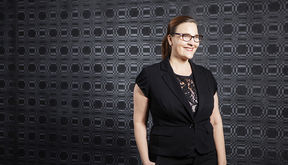Professor Paula Hohti receives two million euros of ERC funding for research into renaissance fashion and culture

Aalto University Professor Paula Hohti has been awarded a 2 million euro ERC Consolidator Grant by the European Research Council (ERC). The five-year project, entitled Re-fashioning the Renaissance: Popular Groups, Fashion and the Material and Cultural Significance of Clothing in Europe, 1550-1650, will investigate the meaning and spread of western fashion in 17th century Europe.
Ms Hohti is making a significant step forward for science in the study of fashion, culture and history. In this experimental research, the sense of touch will also be brought into play.
‘We will develop hand-on methods in which we will work in many different ways with the textile samples’. Using manuals preserved from the 16th century, we have access to the textile manufacturing recipes of that time and we can reconstruct them now and see, for example, what the weaving of the fabric meant in practice,’ explains Professor Hohti.
Using up-to-date techniques, we can also experiment with new methods and reconstruct poor-quality articles of clothing. A 3D camera will assist in the modelling process and using 3D printing we can produce woven fabrics and clothing. Fibre and colour analyses reveal details of the living environments in which articles of clothing were used. The intention is that the researchers will also grow flax in their own greenhouse facilities.
Tacit knowledge about the lives of the lower classes
The spread of western fashion in the 16th century was aided by the growth of cities, new manufacturing techniques and the development of printing technology. Fashion began to spread into the life of the average citizen as new and cheaper fabrics became available.
Rather than the resplendent clothing of the rich, Ms Hohti is interested in the lives of the working classes.
‘We will focus on the spread of textiles and fashion among barbers, tailors and shoemakers in Italy and Scandinavia during the period 1550–1650. There is much tacit knowledge in the articles of clothing. For example, a refined fabric produced by a poor family can tell of things not found in the history books’.
Ms Hohti is looking forward with excitement to getting access to a significant textile and clothing collection discovered at a metro construction site in Copenhagen. The discovery is like a fashion history researcher’s dream: a large quantity of wigs, shoes, hats, socks and other articles of clothing used by the people from the 17th century onwards.
The ERC will be funding the ground-breaking cutting-edge research, and the project, due to begin in April, will be a continuation of Ms Hohti’s more than ten years of international research work.
‘This funding makes possible everything that a researcher could dream of. I will have a five-strong paid research team in which each person can focus on their specialist area. We will also get to be trained in historical craft skills such as dyeing methods and linen weaving’.
Read more news

Your voice gives away valuable personal information, so how do you keep that data safe?
With speech technologies becoming increasingly common, researchers want to make sure we don’t give away more information than we mean to.
Aalto in 2025: Quantum leaps, creative breakthroughs and solutions for a better life
Growth, technology and industrial renewal; human-centred solutions; health and everyday wellbeing; and enjoyable daily life and thriving communities.
Research Council of Finland establishes a Center of Excellence in Quantum Materials
The Centre, called QMAT, creates new materials to power the quantum technology of coming decades.






